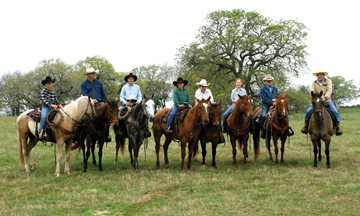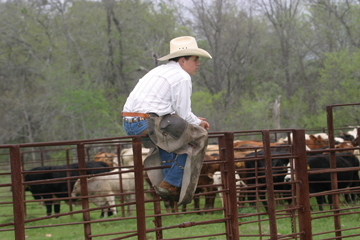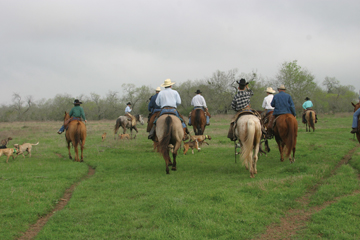Photography by Lynn Glenewinkel
Some people think the cowboy way of life has disappeared from the prairies—gone forever with the cattle drives and steam locomotives. But those people must not be from Texas, or they would know better.
Coming from a long line of cattle ranchers in the plains of South Central Texas, the family of John and Nancy Cook are living proof that the life of a full time cowboy is a full and happy one, a busy one, and a blessing. 
Many Texans today still make their living as cattle ranchers. On the gentle hills around Nixon, Texas (pop. 1,990), the Cook family has lived and worked for over one hundred years, and since 1947 John and Nancy have run cattle on their 5,400 acre ranch. The Nixon newspaper is even called the Cow County Courier.
“We don’t have anything fancy here: just nuts and bolts ranching,” says John with a shrug.
And lots of cattle.
“I guess we’ve got about 800-1,000 head right now,” says this seasoned Texas cowboy whose cool blue eyes match his denim work shirt.
“That number depends on how many sales he’s been to. He says he’s just going to check out prices and not gonna buy anything, and then he comes home with a trailer full of cattle,” says his wife, Nancy. The Nixon Livestock Auction is held every Monday morning, and it is marvelous to behold the cattle and the cowboys breathing in the excitement of the auction and the fresh morning air.
Having raised four children, enjoying 10 grandchildren, and two great grandchildren, the Cooks will tell you that, while their family is their whole life, cattle ranching is too.
“All the kids are involved in one way or another. We get everyone together about twice a year to help pen the cattle, work the babies, cut out what we want to sell, load them up, and ship them out. But that’s just everyday life for us,” says John.
First, there’s the branding all the cattle and the ear marking of all the calves. (“That helps us keep inventory,” explains John), and then there’s the hard work of keeping the cattle fed throughout the winter when there’s not enough grass to graze.
Of course, there’s also the necessary and sometimes difficult task of rounding up the animals, vaccinating them, and making sure they’re all healthy. Then there are the dogs and horses that need care and feeding, as well as the constant maintenance of fences, tractors, trucks, and farm equipment. Be assured, keeping it all running smoothly is no small feat.
But is the cowboy life still like we remember from the movies? Surprisingly enough, it is!
“We still ride horses and gather the cattle like we used to in the past,” says John. “I’ve been riding since I was five years old. I ain’t gonna quit. Everybody I know that quits or retires just gives up and dies, and I ain’t ready to die. So I ain’t quitting,” says John with rugged resolve and determination.
“All my kids and grandkids ride, too, and my great grandkids have even started riding,” says John. His wife Nancy is the only one who doesn’t ride, but if she wanted to she could since they only have ten horses on the ranch right now.
The Cook’s business is a cow-calf operation. They raise cross-bred Brahman-Brangus cattle and Angus-Charolais bulls. Then, about twice a year, in the late winter and early fall, Cook takes them to auction.
“I sell most of them here, but I ship some direct every once in a while,” explains John.
“Cattle ranching is a good way of life. You have to like it or you’d have to do something else. You could work 8-5 in some other job and come home and be done with it, but not this one. It’s really dawn to dusk work, and even in the middle of the night you have to get out of bed if the county sheriff calls you because your cows got in the road,” says John. “But I love this life: it’s all I’ve really ever done, and all I’ll ever do.” 
So what is the typical day in the life of a Texas cowboy?
“Well, I’ve been getting up early, around four a.m., most all my life. I’m never in bed later than five,” says John without complaint.
One of the sweetest and most telling things about the 55 year marriage of John and Nancy is that every morning he lets her sleep in while he makes her breakfast.
“I get up a little after five; that way he fixes it for me,” smiles Nancy.
Then John is out the door.
“Every morning, I go to town to the Main Street Drug Store for daylight coffee with my buddies. We get our worldly events all solved. It’s kind of a habit before the world wakes up,” he says.
Then John is back at the ranch getting the work underway. “I get the boys off [his son-in- law and the hired hands that work the ranch] to do what needs to be done. They’ll feed the cattle, put out hay, and work on a fence— just whatever it takes.”
The day passes quickly as they rebuild pens and do general maintenance on the whole area. They also do 90% of the water well work that needs to be done.
“We have five wells on the property, and they always need attention,” says John.
As Nancy says, “This work entails things most people don’t even think about.”
“A cowboy has to be half veterinarian, half feed man, half babysitter, and all that kind of stuff,” says John.
“We try to get most of the calves birthed by the first of January and ready to sell by July. The weather, like extreme drought, can throw your breeding season off, and it takes a while to get it back on cycle,” he explains, “And of course you have to worm the cattle about twice a year, too. You have to put them through chutes and tag them, ad you have to vaccinate every new calf that hits the ground. There’s just a whole lot to do. Then we try to sell them at a 600 pound average. I do not like to sell light weight calves.”
But what do cattle go for these days at auction?
“I saw young cows sell today anywhere from $1,000 to $1,600. Black bald-faced calves, pretty classy ones, take a minimum of three years to pay for. I figure I have to have $400 a head on my sale of a calf to break even—just to pay for its upkeep. They are expensive these days: it is very unusual to have a wet year and high prices all at the same time. If the weather is good, grass grows and you don’t have to spend so much on feed, but the cattle prices have been high lately,” says John.
The Cook’s son-in-law Sam Henderson shakes his head in agreement. He, too, understands the expense and hard work involved in running a successful cattle ranch:
“You’re married to the work, 24 hours a day, seven days a week. It has its advantages and disadvantages, good and bad,” says Sam.
“Of course there’s all the paperwork they have to do, too,” explains Nancy. “There are records you have to keep straight, things you have to give your accountant in order to tell you what you owe the Government.” Not old fashioned or out of touch in the least, John (who is 74 years young) keeps up with his calves, checks their tags, and stores all ranch information on his computer.
“Well, we had a few choice words come out while we tried to learn a computer. My son ran over here a few days and nights to help us out,” admits John.
Not shy of new technology, John admits that sometimes since his heart surgery last year, he uses his red pick up truck and honks his horn to gather in the cattle that way. “The majority of them know that horn and come in that way for food. Others are more stubborn and need the horses to bring them in.” When they have to feed the cattle, they use coastal hay that they’ve grown themselves for their own use.
Horses aren’t the only animals cowboys depend on when rounding up the cattle. Cow dogs are indispensable: “I wouldn’t go out to pasture with out them. It would just be a waste of time,” says John.
 “One good cow dog is worth three men, and one bad one makes for a long day,” chuckles Sam. “One good cow dog is worth three men, and one bad one makes for a long day,” chuckles Sam.
“We have hog dogs, too. We have a real problem with wild hogs. They really make your pastures rough by digging it all up. The kids get a kick out of hunting them, but the hogs still just multiply too fast,” says John. “We use the dogs to chase them so we can catch them. It’s not so elegant to watch: we just turn them lose and they go nuts.”
Cook, who is the past director of the Independent Cattle Association of Texas, is now on the Cattleman Beef Board, appointed to that seat by the Secretary of Agriculture, and he has served five of a six year term. He is also involved in the National Cattlemen’s Beef Association conferences.
“The board’s work is important. For example when the mad cow disease thing was going around, we were able to work to get the word out and get information to ranchers. It stopped a lot of confusion and misinformation and helped us get over that crisis very quickly,” explains John.
Some cattle ranches have deer leases and hunting packages to help sustain them. But even though some Texas ranchers have other sources of income, there are still many who make the cowboy way of life their whole life.
“There are still a lot of people just like us—they’re out there working the cattle, and that’s the way they live,” says John. “We love it and wouldn’t trade this life for anything.”
|